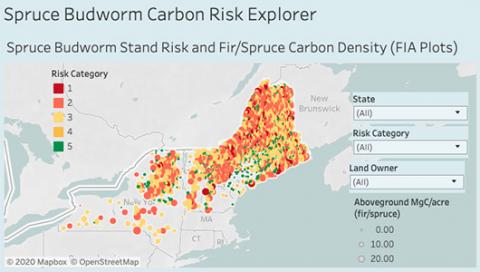Silvicultural Strategies for Mitigating Northern Forest Carbon Reversal Due to Spruce Budworm

An outbreak of eastern spruce budworm (SBW) is projected to impact the Northern Forest Region in the coming decade, and many forest stands in the region are at risk of substantial disturbance. The direct impacts of SBW and associated salvage harvests or pre-salvage activities carry risks of carbon reversal, which must be factored into eligibility and pricing for forest-based greenhouse gas offsets in the region. With looming outbreaks of both native and non-native insect pests, landowners and forest managers in the Northern Forest region are likely to face more frequent situations where they will need to decide whether salvage harvesting is an appropriate management response.
NSRC researchers used a modeling approach, based on current data from the U.S. Forest Inventory and Analysis (FIA) program, to understand the value and carbon consequences of salvage, pre-salvage, and business-as-usual scenarios across a range of stand risk profiles, both in the presence and absence of a SBW attack. Researchers also focused on greenhouse gas consequences and the development of operational guidance for pre- and post-attack silviculture that can help mitigate carbon impacts and put high-risk stands on a more sustainable trajectory.
Salvage harvesting designed to mitigate pest impacts over time can have positive impacts on overall carbon balances by reducing the risk of catastrophic loss in susceptible stands and landscapes and by shifting carbon from at-risk or dying trees to wood used as building materials or displacing fossil-fuel intensive energy sources. But this carbon resilience comes at a short-term cost to the atmosphere that can last up to 20 years.
